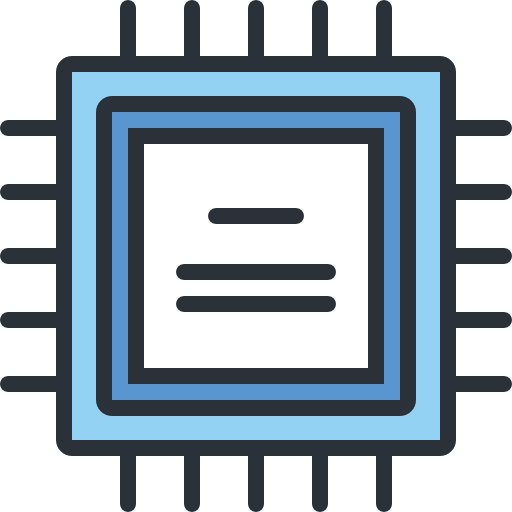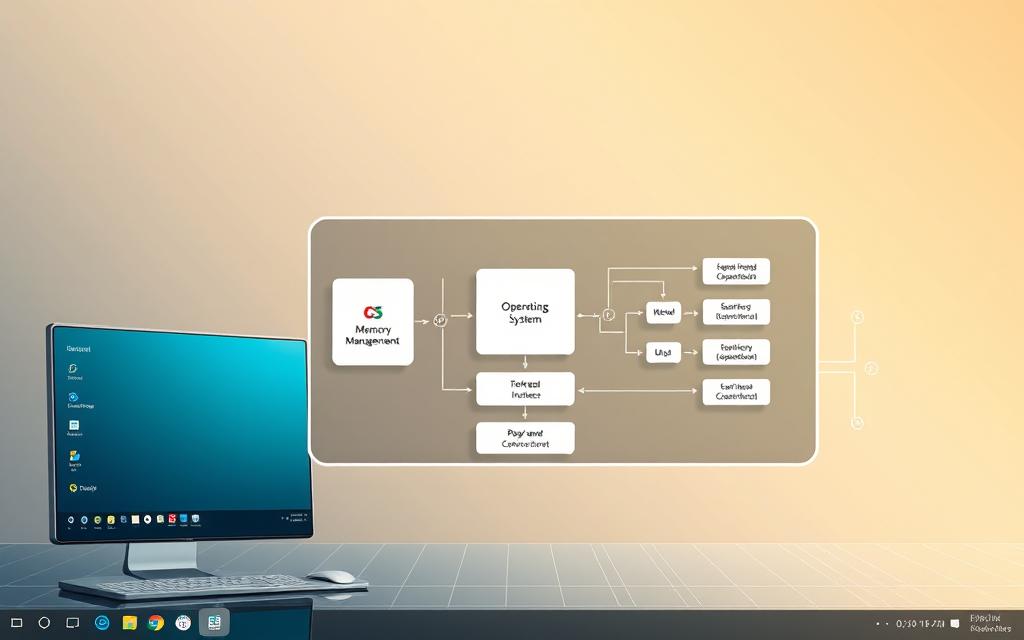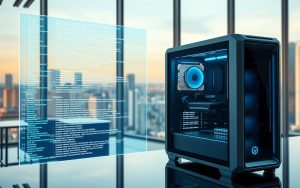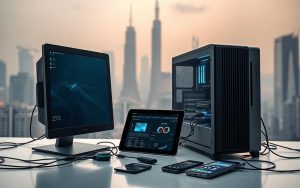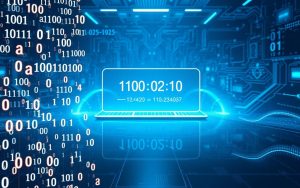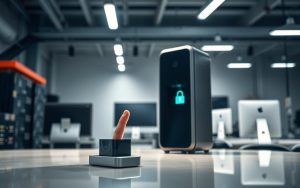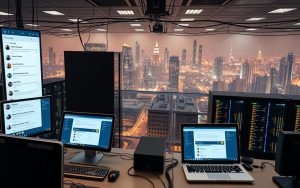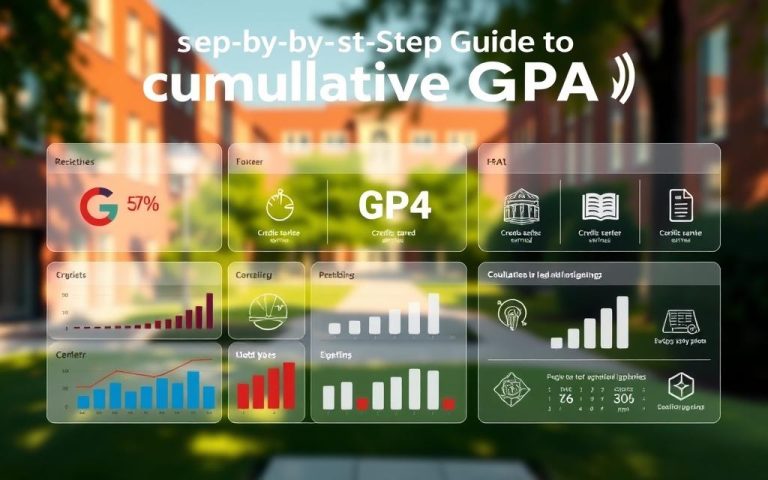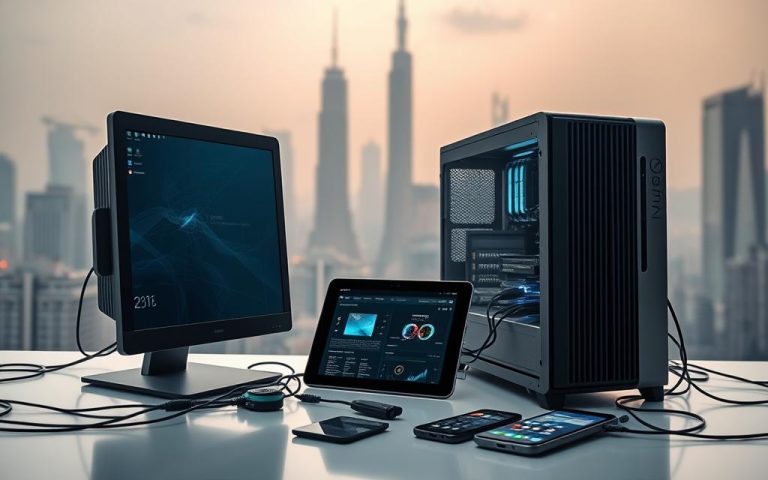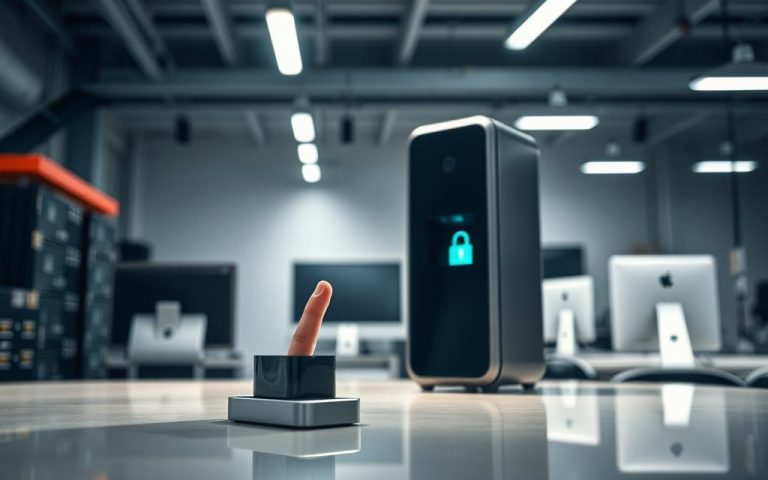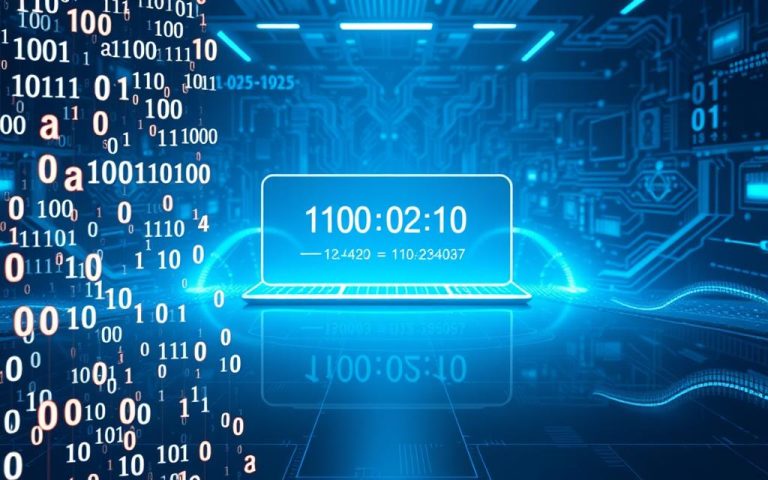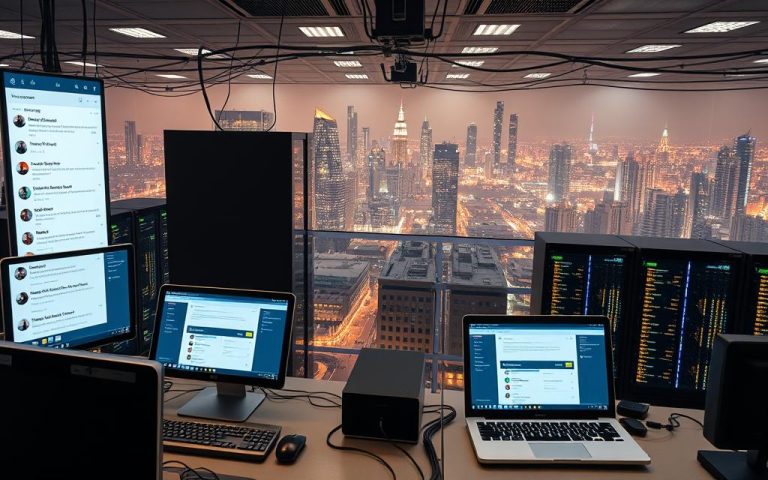Operating Systems in Computers: Definition & Basics
Every modern computing device relies on core software to manage hardware and run programs efficiently. This essential layer, known as an operating system, bridges the gap between physical components and applications. Without it, developers would need to write code for every hardware interaction, slowing progress.
Early computers lacked standardized management tools, forcing each application to handle low-level tasks. Today’s solutions streamline development by providing resources like memory allocation and security protocols. Popular examples—Windows, macOS, and Linux—demonstrate how diverse interfaces cater to different users.
From single-task beginnings to today’s multitasking environments, these platforms have evolved dramatically. They now offer graphical interfaces, real-time processing, and cloud integration. Subsequent sections will explore their critical functions in detail.
What Is Operating System in Computer Definition?
Behind every smooth-running device lies a powerful mediator coordinating its functions. This core layer manages hardware resources like CPU cycles, memory, and storage while ensuring software runs without conflicts. Without it, even simple tasks—like printing a document—would require manual coding for each component.
Resource Management and Hardware Abstraction
An OS acts as a traffic controller for system resources. It allocates CPU time, prevents memory leaks, and prioritizes tasks. For example, a printer driver translates universal commands into specific instructions for different models. This abstraction lets developers focus on features, not hardware quirks.
Bridging the Gap Between Layers
Standardized APIs enable applications to work across diverse devices. When a video editor saves a file, the OS handles storage details. Process isolation prevents crashes from spreading, boosting stability. Modern systems like Windows Registry streamline device configurations centrally.
| Scenario | Without OS | With OS |
|---|---|---|
| Running Multiple Apps | Manual resource分配 | Automated scheduling |
| Hardware Interaction | Device-specific coding | Driver abstraction |
| Memory Management | Risk of corruption | Protected virtual space |
Early programmers wrote direct hardware commands, slowing development. Today’s operating systems eliminate this friction, letting innovations thrive. From gaming to cloud computing, this foundation remains indispensable.
Key Functions of an Operating System
Modern computing thrives on efficiency, and the backbone of this efficiency lies in robust management capabilities. Core responsibilities include juggling multiple tasks, optimizing memory usage, and ensuring seamless data access. These functions work together to create a smooth user experience.
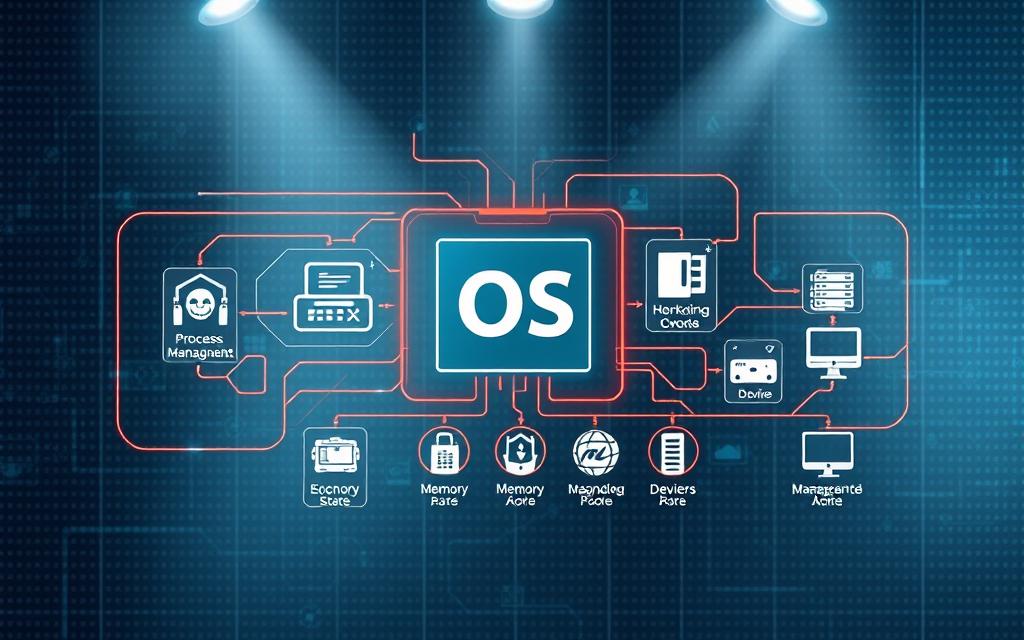
Process Management and Multitasking
Efficient process handling allows multiple applications to run simultaneously. The OS uses scheduling algorithms like round-robin or priority-based systems to allocate CPU time fairly. Tools like Windows Task Manager provide real-time insights into active processes.
Time-sharing techniques split CPU resources into tiny slices. This approach prevents any single application from monopolizing performance. Linux’s top command demonstrates how systems prioritize critical tasks dynamically.
Memory Allocation and Virtual Memory
Physical RAM limitations are overcome through virtual memory techniques. When main memory fills up, the OS swaps less-used data to secondary storage. This expansion of address space lets resource-intensive programs operate smoothly.
Protection mechanisms prevent unauthorized access between processes. Each application gets isolated memory space, reducing crash risks. Modern systems also employ encryption for sensitive data handling.
File System and Data Storage
Structured storage solutions organize data efficiently across drives. Popular architectures include:
- FAT32 for compatibility
- NTFS for Windows security features
- ext4 for Linux performance
Directories and indexing enable quick file retrieval. The OS maintains metadata like creation dates and permissions, streamlining file operations.
Device and Network Management
Hardware interaction is simplified through standardized drivers. Plug-and-play functionality automatically configures peripherals like printers or storage devices. This abstraction layer saves developers from writing device-specific code.
For connectivity, integrated network stacks support protocols like TCP/IP. The OS handles packet routing, firewall rules, and bandwidth allocation. These features enable seamless internet access and local resource sharing.
| Function | Benefit |
|---|---|
| Process Scheduling | Balanced CPU usage |
| Virtual Memory | Extended workspace |
| File Systems | Organized storage |
| Network Stack | Reliable communication |
From smartphones to supercomputers, these fundamental operations power every digital interaction. They transform raw hardware into responsive, user-friendly environments.
User Interfaces: CLI vs. GUI
From text-based commands to touch-responsive screens, interfaces shape our digital experiences. The choice between a command-line interface (CLI) and a graphical user interface (GUI) depends on task complexity and user expertise. Each method offers unique advantages in modern computing environments.
https://www.youtube.com/watch?v=bc_BgsqvVHI
Command-Line Interface Basics
CLI traces its roots to teletype machines, where users typed directives line by line. Today’s terminals, like Linux Bash or Windows Command Prompt, retain this efficiency for:
- System administration: Fixing issues or managing remote machines.
- Automation: Scripting repetitive tasks with precision.
- Cloud computing: Deploying virtual resources via typed commands.
Power users favor CLI for its speed and low resource use. Network admins rely on it to configure routers or troubleshoot connectivity without graphical overhead.
Graphical User Interface Evolution
GUIs revolutionized access with visual elements like icons and windows. Pioneered by Xerox PARC in the 1970s, they became mainstream with Apple’s Macintosh and Windows OS. Key milestones include:
- Mac OS System 1 (1984): Introduced drop-down menus.
- Windows 95: Popularized the Start button and taskbar.
- Touch UIs: Smartphones like iPhone adapted GUIs for finger gestures.
GUIs excel in accessibility, letting casual users navigate intuitively. Voice-controlled interfaces now extend this convenience further.
| Interface | Best For | Limitations |
|---|---|---|
| CLI | Automation, remote management | Steeper learning curve |
| GUI | Everyday tasks, visual workflows | Higher resource usage |
Hybrid systems like Windows PowerShell blend both worlds, offering CLI speed with GUI-like scripting. As interfaces evolve, they continue to redefine how we interact with technology.
Types of Operating Systems
Digital environments demand specialized platforms tailored to distinct computing needs. From personal computers to medical devices, each category relies on optimized software architectures. These variants balance performance, usability, and hardware constraints.
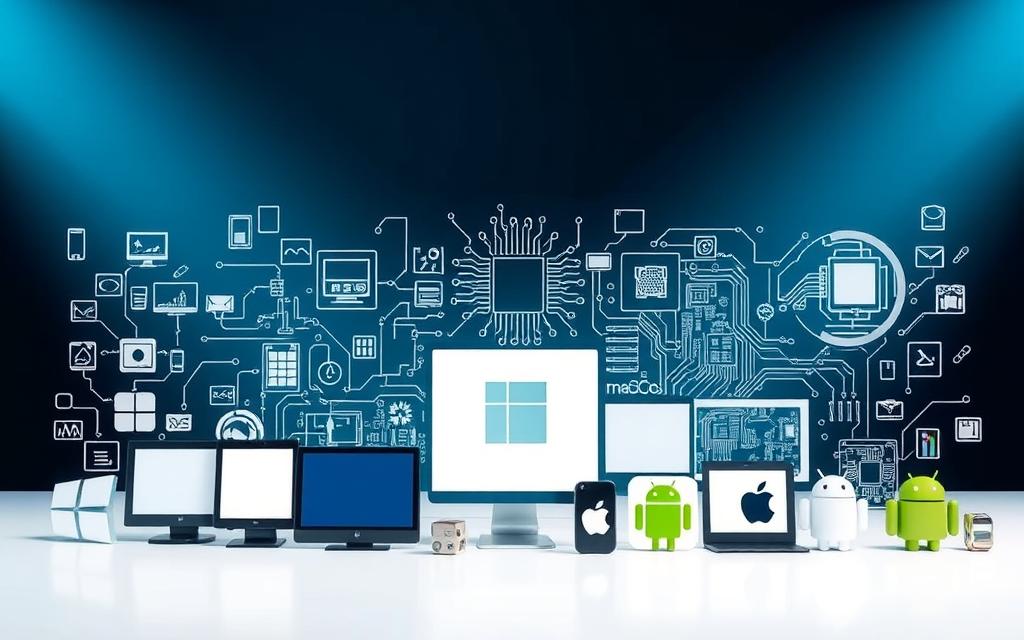
General-Purpose OS: Windows, macOS, Linux
Desktop operating systems handle diverse tasks, from gaming to office work. Windows dominates personal computers, while macOS integrates tightly with Apple hardware. Linux, an open source alternative, powers servers and developer workstations.
Key differences include:
- Windows: Broad hardware compatibility, proprietary.
- macOS: Unix-based, optimized for creative workflows.
- Linux: Modular kernels (monolithic vs. microkernel).
Mobile Operating Systems: iOS and Android
Mobile operating systems prioritize touch interfaces and battery efficiency. iOS offers a walled-garden ecosystem, while Android’s open source Linux kernel supports customization. Both optimize kernels for smartphones and tablets.
Android’s adaptations include:
- Power-saving process scheduling.
- Touchscreen driver optimizations.
- Sandboxed apps for security.
Embedded and Real-Time Systems
These platforms ensure reliability in critical applications. Industrial robots use RTOS for
Examples:
- FreeRTOS for IoT sensors.
- VxWorks in aerospace systems.
Network and Distributed OS
Servers and clusters use these to manage shared resources. Windows Server and Linux clusters balance loads across machines. They enable core OS functions like centralized authentication.
| Type | Use Case |
|---|---|
| General-Purpose | Everyday computing |
| Mobile | Smartphones, tablets |
| RTOS | Medical devices |
How Operating Systems Manage Hardware
Efficient hardware coordination separates functional systems from chaotic setups. The system provides structured methods for components to communicate through specialized protocols. This orchestration ensures printers, storage drives, and GPUs work harmoniously.
Device Drivers and Plug-and-Play
Modern devices connect seamlessly thanks to driver stacks. Kernel-mode drivers handle critical operations like memory access, while user-mode drivers manage application interfaces. This layered approach prevents crashes from affecting core functions.
Plug-and-Play technology automates configuration through ACPI firmware. When connecting a USB drive:
- The OS detects voltage changes on the port
- Firmware assigns resources like IRQ channels
- Appropriate drivers load within seconds
Direct Memory Access (DMA) controllers boost performance. They allow storage devices to transfer data without CPU involvement. This proves crucial for 4K video editing or database operations.
Input/Output (I/O) Operations
Efficient data flow relies on intelligent control mechanisms. Interrupt-driven I/O lets hardware signal readiness instead of constant CPU polling. For example, keyboards trigger IRQ 1 when detecting keypresses.
Storage hierarchies demonstrate advanced input output management:
| Interface | Throughput | Use Case |
|---|---|---|
| SATA III | 600MB/s | Hard drives |
| NVMe | 3500MB/s | SSDs |
GPU acceleration showcases specialized driver capabilities. Graphics processors handle parallel computations through dedicated control paths. The system provides APIs like DirectX to standardize these interactions.
Hot-swapping exemplifies dynamic hardware management. Thunderbolt ports can add external GPUs while the system runs. This flexibility powers creative workflows and mobile workstations alike.
Process Scheduling and Resource Allocation
Modern CPUs juggle countless tasks through sophisticated scheduling techniques. This invisible management layer determines which process gets CPU attention and for how long. Without it, your video call would freeze while loading a webpage.
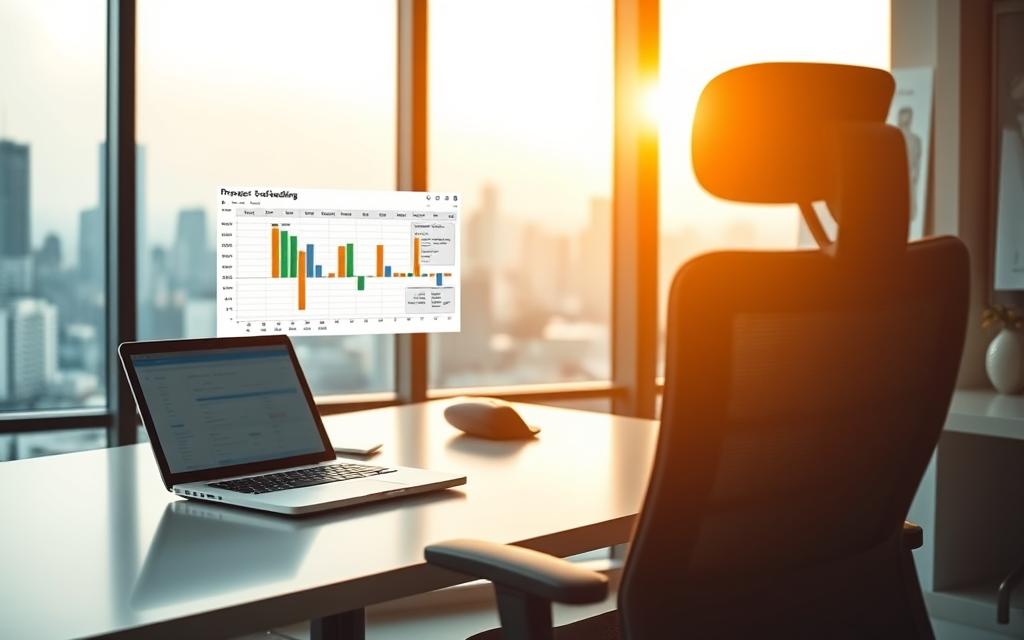
- FIFO: First-In-First-Out queues tasks like a printer line
- SJN: Shortest Job Next prioritizes quick tasks
- Round Robin: Gives each process equal time slices
Multilevel feedback queues blend these methods dynamically. Quick tasks get priority, while CPU-intensive programs run in background queues. Linux’s Completely Fair Scheduler (CFS) perfects this balance.
Context switching between processes creates overhead. Modern kernels mitigate this through:
- CPU cache affinity optimizations
- Thread-local storage
- Hardware-assisted virtualization
Multi-core systems face load balancing challenges. Windows NT scheduler uses core parking for energy efficiency. It activates cores only when needed, reducing power consumption by up to 30%.
Priority inversion occurs when low-priority tasks block critical ones. Solutions include:
- Priority inheritance protocols
- Deadlock detection algorithms
- Real-time scheduling classes
Containerization reshapes resource allocation. Docker and Kubernetes isolate services while sharing kernel space. This approach maximizes hardware utilization without VM overhead.
Mobile devices demand special considerations. Android’s energy-aware scheduler:
- Limits background process CPU access
- Groups wake-up alarms
- Scales frequencies dynamically
These techniques ensure responsive interfaces while preserving battery life. From desktops to smartphones, intelligent scheduling remains the unsung hero of smooth performance.
Security Features in Modern Operating Systems
Cyber threats evolve rapidly, demanding robust protection layers in every digital environment. Contemporary platforms combine hardware-level safeguards with intelligent software protocols. These measures protect sensitive data while ensuring authorized access across devices.
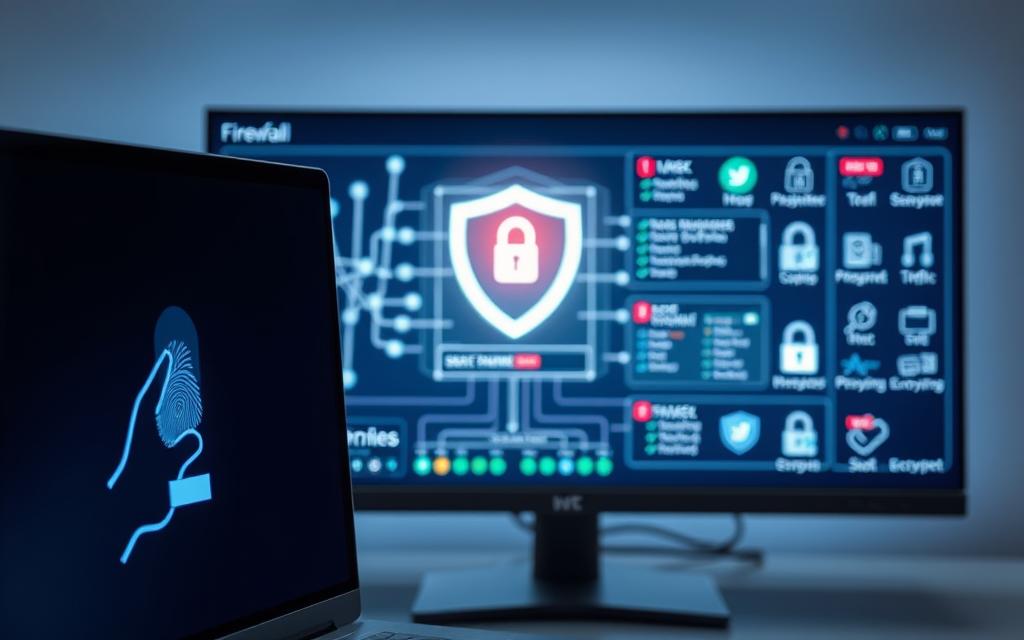
User Access Controls
The principle of least privilege governs modern permission systems. Instead of admin rights for all tasks, users get precisely scoped capabilities. Windows Hello exemplifies this with biometric authentication tied to specific file access levels.
Linux enhances this through SELinux’s mandatory controls. Key implementations include:
- Role-based access for team hierarchies
- Attribute-based rules for temporary privileges
- Time-bound credentials for contractors
Encryption and Data Protection
Full-disk encryption like BitLocker (Windows) and FileVault (macOS) scrambles data at rest. Trusted Platform Modules (TPM) chips store encryption keys physically, preventing software-based theft. Secure boot processes verify OS integrity before loading.
Sandboxing techniques isolate applications using:
- Virtualized memory spaces
- Hardware-enforced process boundaries
- Automated certificate revocation for compromised code
| Feature | Windows | macOS | Linux |
|---|---|---|---|
| Filesystem Encryption | BitLocker + TPM | FileVault | LUKS/dm-crypt |
| Access Model | Role-based | Gatekeeper + SIP | SELinux/AppArmor |
| GDPR Compliance | Enterprise data tagging | Privacy preferences API | FSF-certified distros |
These security layers work silently, balancing protection with usability. From facial recognition logins to self-encrypting SSDs, modern systems embed safeguards at every level.
Operating System Kernel: The Core Component
At the heart of every digital device lies a powerful engine that orchestrates all operations. This kernel manages hardware resources while isolating applications for stability. It operates in protected memory space, separate from user programs.
Modern designs balance speed and security through architectural choices. Monolithic kernels like Linux run all services in kernel space for performance. Microkernels like MINIX move drivers to user space for resilience against crashes.
The system divides memory into two distinct zones:
- Kernel space: Handles critical functions with hardware access
- User space: Runs applications with restricted privileges
Applications request services via system calls. These act as gateways, triggering context switches between spaces. Windows NT uses interrupt gates, while Linux employs faster SYSCALL instructions.
Hybrid designs like macOS XNU blend approaches. They keep essential processes in kernel space while moving non-critical components outward. This balances speed with modularity for driver updates.
Security vulnerabilities like Spectre revealed risks in speculative execution. Modern systems now implement:
- Kernel page-table isolation
- Hardware-enforced stack protection
- Restricted indirect branch prediction
Real-time variants prioritize deterministic response times. They modify scheduling algorithms for industrial automation and medical devices. Loadable modules let administrators add features without rebooting.
From smartphones to servers, this architectural part remains foundational. It evolves continuously to meet new performance and security demands.
Evolution of Operating Systems: A Brief History
From punch cards to touchscreens, software foundations have transformed dramatically. Each generation introduced breakthroughs that redefined how we interact with machines. This progression mirrors society’s growing demands for efficiency and accessibility.
From Mainframes to Personal Computers
Early computing relied on batch processing—users submitted jobs that ran sequentially. UNIX’s 1969 debut at Bell Labs introduced multitasking capabilities. Its modular design influenced later versions like BSD and Linux.
The DOS-to-Windows shift revolutionized personal computers. Microsoft’s GUI made technology accessible beyond specialists. “We wanted to put a computer on every desk and in every home” became their driving vision.
Standardization efforts like POSIX ensured compatibility across UNIX versions. This allowed developers to write portable code—a foundation for today’s cross-platform applications.
The Rise of Mobile and Cloud OS
Smartphone battles saw Symbian’s early lead overtaken by iOS and Android. Google’s platform now holds 46% market share, proving open-source adaptability. These mobile devices required new optimizations:
- Touchscreen responsiveness
- Battery-efficient scheduling
- App sandboxing for security
Virtualization enabled cloud computing by abstracting hardware resources. Containerization then improved efficiency through shared kernels. Docker demonstrated how lightweight isolation could replace bulky virtual machines.
Edge computing now pushes processing closer to data sources. Future platforms may blend real-time analytics with AI decision-making—continuing the cycle of innovation that began with simple batch jobs.
Popular Operating Systems Today
Global adoption patterns reveal stark contrasts between desktop and mobile ecosystems. While Microsoft Windows commands personal computers, Linux powers enterprise infrastructure. Mobile devices show even greater polarization between platforms.
Desktop Platform Competition
Windows 11 maintains 80% desktop dominance with hybrid work features:
- Snap Layouts for multitasking
- DirectStorage API for gaming
- Android app integration via WSA
macOS Sonoma counters with creative workflow enhancements. Its Stage Manager organizes windows dynamically, while Continuity Camera turns iPhones into webcams. Linux distributions like Ubuntu appeal to developers with open source flexibility.
Mobile OS Battleground
Android’s 46% global share stems from device diversity. Its open source core allows manufacturers to customize interfaces. iOS maintains premium positioning through tight hardware-software integration, especially on tablets.
Key differentiators for smartphones:
- Android: Custom launchers, sideloading
- iOS: FaceID security, AirDrop sharing
Emerging and Specialized Platforms
ChromeOS gains traction in education with cloud-centric simplicity. Google’s Fuchsia OS may unify smart devices using microkernel architecture. Server environments rely on:
- Windows Server for Active Directory
- RHEL for enterprise stability
| Platform | Market Share | Key Strength |
|---|---|---|
| Windows 11 | 26% (all devices) | Enterprise compatibility |
| Linux | 90% (cloud) | Customization |
| Android | 46% (global) | Hardware choice |
Gaming consoles showcase specialized adaptations. Xbox Series X/S uses a Microsoft Windows core with DirectX optimizations. PlayStation 5’s Orbis OS builds on FreeBSD for graphics performance.
Future Trends in Operating Systems
Technological frontiers are pushing digital platforms toward unprecedented capabilities. Emerging hardware like quantum processors and spatial computing devices demands radical software rethinking. These advancements will redefine how systems allocate resources and secure data.
AI-integrated kernels represent the next evolution in resource management. Instead of reactive allocation, predictive algorithms will:
- Anticipate memory needs before application launches
- Dynamically adjust CPU/GPU/TPU workloads
- Preemptively cache frequently used data
Quantum computing introduces entirely new architectural requirements. Open-source prototypes already demonstrate:
| Feature | Classical OS | Quantum OS |
|---|---|---|
| Error Correction | Binary checksums | Qubit stabilization |
| Processing Model | Sequential | Superposition-based |
| Network Needs | Standard protocols | Quantum encryption |
Extended reality platforms demand spatial interaction models. AR/VR headsets use advanced tracking for:
- Gesture recognition at sub-millimeter precision
- Eye-tracking optimized rendering
- Haptic feedback synchronization
“Pluton processors create hardware-rooted security that travels with the device—a revolutionary approach for modern threats.”
5G/6G network integration will transform mobile platforms. Low-latency capabilities enable:
- Real-time edge computing offloading
- Seamless device-to-device synchronization
- Network-slicing for mission-critical applications
Neuromorphic architectures challenge traditional designs. Brain-inspired chips may use:
- Spiking neural networks for pattern recognition
- Memristors for analog memory processing
- Event-driven computation models
These innovations promise to redefine our relationship with technology, making interactions more intuitive while handling exponentially complex workloads.
Conclusion
The digital backbone of every computing experience remains unseen yet indispensable. Operating systems enable hardware abstraction, letting software thrive without direct hardware coding. From desktops to IoT devices, they adapt to diverse needs while maintaining core functionality.
Security demands grow as ecosystems interconnect. Modern platforms integrate firewalls, encryption, and biometric checks. Cross-platform compatibility challenges persist, requiring tailored APIs for each environment.
Specialization accelerates—real-time kernels for medical devices, lightweight builds for mobile. Performance and usability tradeoffs shape design choices. IT professionals must master these nuances to optimize computer environments.
As operating systems evolve, their role in AI and quantum computing will redefine digital landscapes. Understanding their foundations ensures we harness future innovations effectively.
